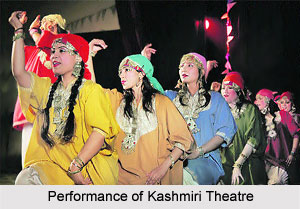 Development of Kashmiri theatre has been a gradual process and the golden period lasted for 1500 years, from the start of Christian era to fifteenth century. Very little of the dramatic literature descended on Kashmiri theatre, and that too only in Sanskrit language, yet theatre was closely associated with royal glamour. There was also present the conventional vernacular theatre (old Kashmiri), which, unlike the high class drama, was based on natural folk imitation of elemental life - birth, death, rebirth, calamities - in connection with the celebrations and festivals of reaping, sowing and threshing.
Development of Kashmiri theatre has been a gradual process and the golden period lasted for 1500 years, from the start of Christian era to fifteenth century. Very little of the dramatic literature descended on Kashmiri theatre, and that too only in Sanskrit language, yet theatre was closely associated with royal glamour. There was also present the conventional vernacular theatre (old Kashmiri), which, unlike the high class drama, was based on natural folk imitation of elemental life - birth, death, rebirth, calamities - in connection with the celebrations and festivals of reaping, sowing and threshing.
Old Forms of Kashmiri Theatre
Ancient from of Kashmiri theatre, the naive and unschooled - Lagun ("Imitation"), any person could mimic for entertaining the king, sadhu, soldier, bridegroom and other noted and respectable social people. The main function of this age old burlesque was only to provoke mirth. Lagun did not at all require professional trainings and certain people called kelak ("buffoons") attained a special prowess in it and adopted it as their profession.
Improvement of Folk Theatre in Kashmir
An enhanced from of Kashmiri folk theatre was the Pethir - a satire, a comedy in which many actors desperately represented individuals, classes or supernatural beings with the motive of ridiculing human follies, frailties and cruelties. Pethirs on communal themes, with musical intervals and energetic harlequins, are still called as Bandi Pethir - a genre preserved through the efforts of Mohammad Subhan Bhagat (1927-93), himself born into a family of these performers.
There flourished, parallel to the Bandi Pethir, a tradition of devotional theatre that mainly aimed at telling the significance of truth and enlightening the happiness of leading a pious life. A repertoire of Hindu plays was always available to the performers and temple premises were the centres of these activities. However, no early manuscript of such drama is extant; among the preserved ones, Satich Kahvet ("Touchstone of Truth") is the oldest accessible to readers. The author, Nandalal Kaul Nana (1877-1940), composed it on the life of Raja Harishchandra, in rhymed dialogue with lyrical interludes. It was first performed in 1932 at Raghunath Mandir, Srinagar. Inspired from the success many young and seasoned writers started to write plays with independent ideas and thoughts.
Post Independence Development of Kashmiri Theatre
With the independence of India, there was a cultural body formed in Jammu and Kashmir named Kashmir Cultural Front (later Congress), and as a result theatre received tremendous attention. Many good and interesting plays were written and composed, that touched mind and soul. The content was highly inspired by the society and politics.
In the year 1974, eighteen repertories working in the Valley established an association known as Kashmir Theatre Federation under the intelligent leadership of Ali Mohammad Lone (1926-87), Pran Kishore, Som Nath Zutshi, Bansi Mattoo, M.L. Kharoo, Moti Lai Kemmu and Makhanlal Saraf. This led to brilliant presentations during that decade - a splendid epoch in Kashmiri theatre - of plays by Kemmu, Pushkar Bhan, Som Nath Sadhu, Sajood Sailani, Farooq Masoodi (Collegepethir, "College Play"), and Mohan Nirash (Rati deny posh, "Bleeding Flowers"). Among the many youthful performers who accomplished noteworthy triumph in those years were actor-directors Shabir Mujahid and Bashir Ahmad Qadri, and Nazir Josh, versatile comedian of the National Theatre (Badgam) and author of popular comic plays like Timi goryi gayi ("Gone Are the Days"), Mwal ("Vagabonds"), and Hazar dastan ("Thousand Tales"). The contribution of Pran Kishore and Ashok Jailkhani (as directors), Gayoor Hassan (for makeup), Abdul Rashid (as set designer), and Abdul Ghani (for special effects) cannot be ignored even in a brief excursus like the present one.
Revival of Kashmiri Theatre
The year that followed, more and more groups joined the Federation and also participated in many theatre festivals. During the 1980s, theatre received fresh impetus, as the JKAACL strived to revive the cultural movement by coordinating the actions of all rural and urban troupes. In the mid 1980s, theatre started to fade away with the possible beginning of militant politics in the state, and came to a standstill by the early 1990s. After ten years` complete lull, National School of Drama (NSD) undertook an idea in 2001 under the intelligent supervision of M.K. Raina, a Kashmiri who had made it big on the national stage.
In the year 2006, Raina, through the workshop, directed two plays in collaboration with the NSD, JKAACL, and the Centre for Heritage and Culture of Kashmir. Actors like Gul Reyaz, Shahid Lateef, Ovais, Ahmad Tufail, Showket Usman, Umar Rahman Reshi, Nadeem Afzal, Rifat, Marjina, Alamjan Irfan Dar, Sameer, and Zahid Ahmad Zargar formed the new wish for Kashmiri theatre. The same year, Sangeet Natak Akademi and the JKAACL organized a folk festival in Srinagar, where it was heartening to note that the old repertories of folk theatre like Kashmir Bhagat Theatre (Akingam), Kashmir Bandi Theatre (Wahthor), National Bandi Theatre (Wahthor), Folk Ruma Reshi Theatre (Rohmoo), Aziz Folk Theatre (Hiller Arhama), Sultan Bhagat Theatre (Gundpora), Alamdaar Bhagat Theatre (Muhripora), Gulmarg Luki Theatre (Palhalan), and Qazi Kashmir Theatre (Bomie) had resurfaced with bright strength.




















